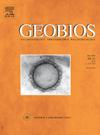在巴拉德地区新发现的中侏罗世恐龙足迹和伊朗北部的动物变化
IF 1.6
4区 地球科学
Q2 PALEONTOLOGY
引用次数: 0
摘要
在三叠纪-侏罗纪时期,西亚地区位于北特提斯沿海地区,是连接欧洲和亚洲动物进化的关键古生物地理纽带。然而,与位于西亚东南部的伊朗相比,该地区早中生代四足动物的记录相对有限,以迹迹记录为主。本文介绍了在伊朗北部Alborz山脉中北带南缘Baladeh地区中侏罗世早期发现的新足迹。这些遗址以鸟臀目(Anomoepus)的基底足迹为主,与类雷龙目(brontopodus)的蜥脚类足迹为伴,并有微小的四足动物游泳足迹。中侏罗统Baladeh ichno动物群中各种食草动物的分布可能受到气候和植被资源变化的影响,也可能受到同时期西南地区鸟目动物辐射中心的影响。要验证这一假设,需要在中东和东亚发现更多的化石证据。本文章由计算机程序翻译,如有差异,请以英文原文为准。
Newly discovered Middle Jurassic dinosaur tracks in the Baladeh region and faunal changes in northern Iran
During the Triassic–Jurassic period, the West Asian region was situated in the coastal area of Northern Tethys and served as a key paleobiogeographic link between European and Asian faunal evolution. However, the Early Mesozoic tetrapod record from this region is relatively limited in contrast to Iran, which is situated in south-eastern West Asia and predominantly characterized by track records. This study presents new tracksites discovered in the early Middle Jurassic of the Baladeh region, southern margin of the North-Central zone Alborz Mountains in northern Iran. These sites are characterized by the dominance of basal ornithischian tracks, Anomoepus, alongside Brontopodus-like sauropod trackways and the occurrence of tiny tetrapod swimming track. The inclusion of various herbivores of the Middle Jurassic Baladeh ichnofauna was possibly influenced by the change in climate and vegetal resources, as well as by the contemporaneous ornithischian radiation center in southwest China. Testing this hypothesis will require the discovery of additional fossil evidence from the Middle East and Eastern Asia.
求助全文
通过发布文献求助,成功后即可免费获取论文全文。
去求助
来源期刊

Geobios
地学-古生物学
CiteScore
3.30
自引率
6.20%
发文量
28
审稿时长
6-12 weeks
期刊介绍:
Geobios publishes bimonthly in English original peer-reviewed articles of international interest in any area of paleontology, paleobiology, paleoecology, paleobiogeography, (bio)stratigraphy and biogeochemistry. All taxonomic groups are treated, including microfossils, invertebrates, plants, vertebrates and ichnofossils.
Geobios welcomes descriptive papers based on original material (e.g. large Systematic Paleontology works), as well as more analytically and/or methodologically oriented papers, provided they offer strong and significant biochronological/biostratigraphical, paleobiogeographical, paleobiological and/or phylogenetic new insights and perspectices. A high priority level is given to synchronic and/or diachronic studies based on multi- or inter-disciplinary approaches mixing various fields of Earth and Life Sciences. Works based on extant data are also considered, provided they offer significant insights into geological-time studies.
 求助内容:
求助内容: 应助结果提醒方式:
应助结果提醒方式:


